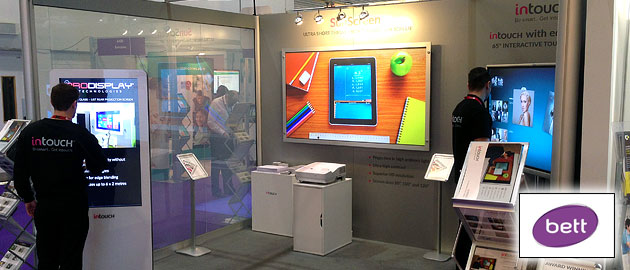Posted January 28th, 2015 by Sean Brown & filed under , General, Technology.
It was great exhibiting at the Bett show this year, fun times! And plenty of serious stuff too of course. We were eager to learn from the very people who use new classroom technologies – educators like you.

Changing needs
We’ve supplied the education sector with a variety of display and touch solutions over the years: universities, museums, primary schools and more, both here in the UK and overseas.
However, the launch of our new intouch division in late 2014 included some brand new products designed specifically to meet the growing and changing needs of the education sector.
The intouch range was on show at Bett, including an interactive kiosk, retro-fit touch frames, front projection SunScreen, switchable glass walls, and our new 65 inch multi-touch interactive monitor – a modern replacement for the ‘whiteboard plus projector’ kit found in many classrooms.
Listening and learning
We managed to scan over 500 badges at the show, and spoke to delegates in various roles across a huge range of educational establishments, both UK and overseas. Schools; universities; academies; adult learning; corporate training; conference venues; content authors; software developers and many more. Phew!
One primary objective at Bett was for us to understand in more detail the frustrations and challenges, the successes and ‘eureka moments’, that educators have experienced when using new classroom presentation technologies.
Five main issues emerged.
Five issues with classroom presentation technologies
Issue 1: Cost of ownership
Replacing projector lamps and filters were a standard recurring expense to be expected, in addition to peripherals such as pens, which sometimes break or get mislaid. And there was always the worry of the kit eventually breaking and needing total replacement.
Our thoughts
The time of the projector and whiteboard solution for classroom interactivity we believe has passed. The reliability and performance of LED panels, along with the rapid development of accurate multi-touch technology, has meant that the slightly clunky projector and whiteboard has transformed into a sleek cutting edge backlit multi-touch interactive screen. LED screens represent an all in one solution with far greater reliability, upgradability, and no need for special peripherals such as interactive pens (they’re still available if you particularly like them of course!).
Issue 2: Image visibility in classroom conditions
Two aspects emerged here: firstly, teachers were frustrated with the inability of existing screens to perform in any kind of direct or ambient bright light; and secondly, the difficulty pupils have seeing the screen when sat at a sharp angle to it.
Our thoughts
High ambient light has always been a challenge for any display, but projector/whiteboard combinations are particularly prone to washing out. Similarly, off-axis readability of lower end projector screens can be compromised by unwanted reflections and glare. Our interactive LED monitors are treated with anti-glare coatings (some on the market are not), and the inherent brightness of the latest LED backlit displays means that screens are readable even in bright ambient light. There may still be occasions where a projector screen is a preferred solution, for example if a larger display is required without interactivity. This is why we developed SunScreen, which has an optical light-rejecting filter to give excellent results even in direct sunlight.
Issue 3: Projector blocking when interacting with screen
Interaction was generally seen as a good thing, however the familiar shadows of heads and hands being cast onto the screen was a frustration. In some cases this was a reason to avoid interacting with the screen at all. (Also, see point 4 below…)
Our thoughts
This is another reason that the ‘projector plus whiteboard’ equation hasn’t quite worked for educators. Today’s LED displays are brightly backlit, so shadows on the screen are a bygone issue. An alternative solution is our Digital Glass, a UST interactive rear projection screen that works using a minimal throw distance and can be manufactured in sizes up to 8m x 3m, with no need to worry about casting shadows on the screen when in use.
Issue 4: Lack of intuitive software
If projector blocking was one reason to avoid interacting with the screen, then the usability of inbuilt interactive software possibly offered another. With any new technology there is a period of growing pains as it matures. This unfortunately affects rates of adoption, and in many cases we discovered that interactive whiteboards were often used as just a secondary display, and any interactive features ignored completely.
Our thoughts
The world of touch software has come a long way, even in the past 12 months. This is clear if you have a touch screen phone, through which you have access to thousands of touch applications, right in your pocket. Applications specific to educators and students are arguably less developed than Instagram, Facebook and the like. But the development and success of those big name apps is already influencing today’s interactive classroom software.
Issue 5: Need to future proof investment in technology
Investment in school technology is always under pressure, so any additional spend is under increasing scrutiny. There was a desire for products that are ‘future proof’, and that offered prospects of genuinely long-term use in the classroom.
Our thoughts
With the intouch range there is no bespoke, inbuilt software that risks becoming out of date. And with our new retro-fit touch frames, we aim to extend the life of older screens, so that schools can squeeze even more value out of their existing ICT investment.
Finally, reliability has been a prime focus in the development of intouch products, and demanding classroom environments (and enthusiastic younger users!) were always at the front of our mind.